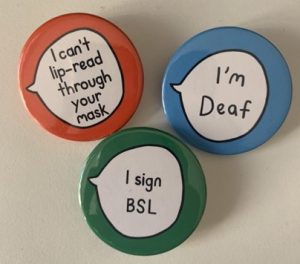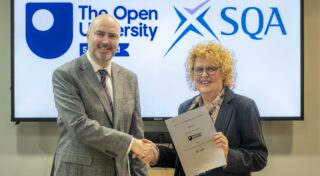Thanks to Alison Hendry, British Sign Language Development Officer at The University of Edinburgh, for writing this guest-blog about the impact of face coverings on the deaf and hard of hearing community. Alison previously worked at Deaf Action and the National Deaf Children’s Society.
The coronavirus pandemic – COVID19 – has dominated our lives for most of 2020. This has resulted in a lot of changes to the way of living, and one example is the use of face coverings. I have been asked to provide a short blog on the impact this has on the deaf and hard of hearing community. This has become an important COVID19-related topic in recent months and there are lots of different informative blogs and resources online which I will share later. This blog is reflective of my own experience and views as a Deaf British Sign Language (BSL) speaker and not that of my workplace.
I am profoundly Deaf and use BSL as my preferred mode of communication, so when it came out that it was recommended to wear face coverings in public spaces I was very anxious about this. BSL is a visual language and uses facial expressions, along with your hands and body language, to convey information. It is important to note that not all deaf people use BSL; some deaf people rely on lip-reading. However, not all deaf BSL users can lip-read. Wearing a face covering immediately takes away half of your face which makes it even more difficult to pick up information, be it through facial expressions or lip-reading. There have been a lot of campaigns for clear masks, as these are better for communication than opaque masks.
Having been out in public spaces, such as the shops, and in the workplace, my anxiety has reduced slightly as I have noticed that people are willing to adapt to meet my communication needs. I have asked people to pull down their mask so that I can lip-read them at a safe distance; the majority have been willing to do this. There are other ways around communicating if people are not comfortable with pulling down their mask, such as using pen and paper, gesturing or using their phone to type out or transcribe what is being said. I have been wearing badges (from Sootmegs) which say ‘I am Deaf’ and ‘I can’t lip-read through your mask’, which I feel has raised awareness when I am out in public.
At the time of writing, the Scottish Government guidance states that face coverings do not need to be worn in the classroom setting, but where there is no guarantee of following the 2m requirement for physical distancing, such as corridors and social spaces, face coverings should be worn. Deaf students will find this difficult as further and higher education is also about socialising, and if their peers or teaching staff do not have any deaf or BSL awareness, it will be harder for the deaf student to be included. This will pose an issue if deaf students are using campus facilities and need to speak to relevant staff who are wearing masks; this will cause a communication issue for the deaf student.
It is important to be aware that every deaf individual has their own needs; there won’t be a ‘one size fits all’ approach so you should speak to each deaf individual you work with to understand what works best for them. There needs to be flexibility around communicating with deaf people, for example, meeting with them in a space that can accommodate all persons while adhering to physical distancing measures. Potentially there will be individuals who do not want to disclose their deafness so any guidance that is produced within a further or higher education institution needs to take into account how every individual – student and staff – can be included.
Further Resources
- National Deaf Children’s Society: https://www.ndcs.org.uk/blog/navigating-the-masked-campus/
- The Limping Chicken, Kirsteen Allison: https://limpingchicken.com/2020/09/04/kirsteen-allison-the-challenges-for-deaf-students-in-a-covid-19-world/
- Demonstration of how wearing a face mask can impact on communication: https://twitter.com/AlisonHendry16/status/1302647355787939842
Here’s a short clip I made about #facemasks & how they impact on communication for me personally. Clear masks > opaque masks. (I’m still anxious about communicating with a mask on but that’s another story) #deaf #lipreading #communication pic.twitter.com/11lexnGhEw
— Alison Hendry (@AlisonHendry16) September 6, 2020









